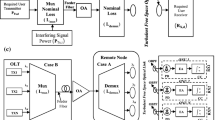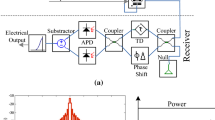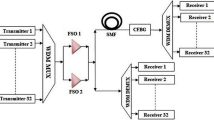Abstract
The last decade has witnessed significant growth of optical communication systems due to low attenuation offered for longer distances with high capacities. Optical wireless communication such as Free space Optical (FSO) systems provide license free secure transmission with lower deployment cost to make it attractive solution for providing communication services in remote areas. However atmospheric turbulences can become major challenges for deploying the FSO systems as it affects its performance. In this work, we propose a 320 Gbps, 32 channel’s hybrid fiber + FSO system using cost efficient On OFF Key modulation by incorporating hybrid dense wavelength division multiplexing scheme. Each channel carries 10 Gbps data segregated by 100 GHz channel spacing. Also, the effect of variant climatic turbulence analyzed for non-return to zero and Return to zero system considering clear sky, light fog, moderate fog and dense fog conditions.
Similar content being viewed by others

Avoid common mistakes on your manuscript.
1 Introduction
In today’s scenario, with the advancement in technology the requirement of high-speed networks is in huge demand which is having its main focus on increasing coverage area along with its transmission capacity. Free space optical communication (FSO) is one of such favorable technology which gives the higher transmission rates as compared to microwave technologies (Amphawan 2021). FSO can provide the secure communication without requirement of license as such required in radio frequency (RF) transmissions. For remote area applications, FSO can become alternate solution as it uses line of sight to meet the demand of higher bandwidth (Parkash 2016). FSO transmits data of optical signal through various band frequencies including visible and infrared which are the part of unlicensed band and thereafter, can easily be accessed by every individual without paying any charges to the external telecom agencies which makes it as cost effective. Since, FSO shares the similar transmitter and receiver as requires in optical fiber communication system, the only difference is in its transmission media. In optical fiber communication systems, transmission medium is through optical fibers whereas FSO systems uses atmosphere as transmission medium (Chaudhary and Amphawan 2014). Moreover, FSO offers significant advantages such as high flexibility, license free, easy installation as well as low deployment cost (Sarangal 2017; Zhang et al. 2019). As, the FSO uses air as the transmission medium so there is no need to laying down the optical fiber inside the earth for transmission which further reduces its cost of deployment. However, there are some atmospheric challenges such as fog, rainfall, dust, snow etc. which limits the performance of FSO system as it increases attenuation through FSO transmission link (Chaudhary et al. 2018; Kaur and Kakati 2020). These atmospheric turbulences should be considered by researchers while designing FSO systems. The DWDM system became main choice in the Optical Networks for meeting the rapidly increasing demands of Bandwidth (Ali et al. 2019). Furthermore, to expand the capacity of optical communication systems, multiplexing schemes such as dense wavelength division multiplexing (DWDM) is used by many researchers. DWDM over FSO communication system is extremely effective in providing high-rate transmission with a very low bit error rate (BER). In section II, we have reported some of previous work which is based on DWDM scheme for FSO systems.
2 Related work
In 2015 (Parkash 2015), the authors have demonstrated a Fiber to the home (FTTH) system by incorporating WDM scheme to transmit 640 Gbps data. The authors have reported the acceptable bit error rate (BER). In 2016 (Parkash 2016), the authors have demonstrated FSO system by incorporating DWDM scheme to transmit 8 channels with frequency spacing of 100 GHz and each one is carrying 8 Gbps data over 4 km FSO link. The reported results show sharp increase in the BER beyond 4 km of FSO range. In 2017 (Kumar and Sharma 2017), the authors have demonstrated Inter-satellite communication link by using DWDM scheme to transmit 5 independent channels, with each one carrying 16 Gbps RZ, with frequency spacing of 100 GHz over 32,500 km without considering any turbulences. In 2018 (Miglani and Malhotra 2018), the authors have demonstrated FSO system by incorporating DWDM scheme with frequency spacing of 100 GHz and each one of carrying 32 × 40 Gbps data over 3 km FSO link. In 2020 (Lema 2020), the authors have demonstrated FSO system by incorporating iterative optimization for 10Gbps data over 5 km FSO link. In that work, the main goal is to reduce the climatic effects by repetitive optimization. In another work (Maraha 2020), the author demonstrated FSO system by incorporating DWDM scheme to transmit 110Gbps data over 9500 m, 3000 m and 2500 m FSO link under the impact of clear weather, haze and heavy haze weather conditions respectively. In another work (Hamzah and Murdas 2020), the author demonstrated FSO system by incorporating Hybrid-DWDM scheme with frequency spacing of 100 GHz to transmit 500 Mbps data with the power of 20 dBm. The rest of paper is further organized as follows: Sect. 3 describes the System Model of Hybrid DWDM and mathematical modelling of weather conditions such as dense fog, moderate fog, light fog and clear weather that cause atmospheric attenuation. In Sect. 4 discussion and results are presented. Finally, Sect. 5 represents the conclusion.
3 System model
Figure 1 shows proposed 32 × 10 Gbps DWDM-FSO system which is modelled in Opti System software. It shows that 32 channels, with each one carrying RZ/NRZ encoded data, are multiplexed together with the help of WDM multiplexer. The NRZ/RZ encoded data is modulated over optical carrier generated from continuous laser with the help of Mech-Zender optical modulator (MZM). The channel spacing between 32 channels is set to be at 100 GHz. The output of WDM transmitter is first transmitted over optical fiber having span of 2 km and then it is transmitted over FSO link.
FSO link consists of transmitter FSO channel and receiver. To calculate power at receiver the link margin, came into existence. Link margin is magnitude relation of received power PR and receiver threshold or sensitivity (\({\varvec{S}}\)) and is sometimes expressed in dB as in Parkash (2016):
For the signal to be recovered at the receiver, its power should be on top of receiver sensitivity. Sensitivity is sometimes given by the manufacturer and it ranges from − 20 to 40 dBm. Power at the receiver is often expressed as in Parkash (2016)
where, ‘\(Pr\)’ and ‘\(Pt\)’ are power at the receiver and transmitter, while ‘\(Arx\)’ is receiver aperture space, ‘\(\theta\)’ is divergence angle, '\(\alpha\)' is region attenuation, and ‘\(L\)’ is the distance between transmitter and receiver. As shown in Eq. (2), power at the receiver is directly proportional to the transmit power and receiver aperture space. So, the received power is often raised by increasing the transmitter power and the receiver space or by reducing the beam divergence of the transmitter beam.
The FSO uses the laser beam to transmit the data through atmosphere. So, the general atmospheric attenuation in FSO link can be described mathematically as (Willebrand and Ghuman 2001):
where, `\(\varvec{\tau}\)' depicts the atmospheric attenuation, ‘\(L\)' is the range and ‘\(\beta\)’ can be given by the following equation:
where, ‘\(\beta abs\)’ depicts the coefficient of absorption and '\(\beta scat\)' depicts the coefficient of scattering [2].
At the receiver side, demultiplexer (DEMUX) is used to split the output of FSO link into the relevant channels. Each channel consists of Optical Gaussian filter to select the particular optical wavelength as transmitted by the transmitter. Avalanche photo diode (APD) is used to detect the optical signal in order to recover the original NRZ/RZ encoded data. BER tester is used to measure the BER at the output APD.
Table 1 shows the various parameters used in the modelling of proposed DWDM-FSO system whereas Table 2 shows the atmospheric attenuation considered in FSO link.
4 Results and discussion
This section discusses the results obtained from the modelling of the proposed DWDM based FSO communication system. Figure 2a shows the emission spectrum of 32 channels DWDM system whereas Fig. 2b shows the 10 Gbps NRZ encoded data in the transmitter.
Figure 3 represents the measured BER for channel 1, channel 8, channel 16 and channel 32 with RZ and NRZ encoding formats under clear weather conditions. At the range of 130 m FSO link, the measured BER for channel 1 is \(10^{ - 15} {\text{and}} 10^{ - 9}\) for NRZ and RZ encoding scheme respectively. In case of channel 8, the measured BER is \(10^{ - 9} {\text{ and}} 10^{ - 8}\) for NRZ and RZ encoding scheme respectively. Similarly, in case of channel 16, the measured BER is \(10^{ - 12} {\text{and}} 10^{ - 8}\) for NRZ and RZ encoding scheme respectively and in case of channel 32, the measured BER is \(10^{ - 12} {\text{and}} 10^{ - 10}\) for NRZ and RZ encoding scheme respectively. Thus, it shows that NRZ performs better than RZ encoding scheme. Figure 4 shows the measured eye diagrams of channel 1, channel 8, channel 16 and channel 32 at the FSO.
FSO link of 110 m. Figure 5 represents the measured optical signal to noise ratio (OSNR) with respect to operating wavelengths for channel 1, channel 8, channel 16 and channel 32 at the range of FSO link of 110 m. It shows that all channels have achieved more than acceptable OSNR≈20 dB.
Figure 6 shows the measured BER for channel 1, channel 8, channel 16 and channel 32 under the impact of light fog atmospheric conditions. It shows that at the FSO range of 125 m, the BER for the channel 1 is \(10^{ - 11}\), channel 8 is \(10^{ - 7}\), channel 16 is \(10^{ - 8}\) and channel 32 is \(10^{ - 9}\). Similarly, Fig. 7 shows the measured BER under the impact of moderate fog conditions. The measured BER for channel 1 is computed as \(10^{ - 11}\), for channel 8 is \(10^{ - 7}\), for channel 16 is \(10^{ - 9}\) and for channel 32 is \(10^{ - 9}\) at the range of 115 m FSO link.
When the atmospheric conditions are further changed to heavy fog conditions, the measured BER for channel 1 is \(10^{ - 11}\), for channel 8 is \(10^{ - 7}\), for channel 16 is \(10^{ - 8}\) and for channel 32 is \(10^{ - 9}\) at FSO link of 105 m (Fig. 8).
4.1 Conclusion
In this work, we have designed FSO system by incorporating DWDM scheme to transmit 320 Gbps data over 2 km optical fiber and 130 m FSO link. For DWDM system, channel spacing between 32 channels are considered as 100 GHz. The FSO link is evaluated under different atmospheric conditions. The reported results from the modeling of proposed high capacity DWDM-FSO system shows the successful transmission of all the channels. Under the clear weather conditions, the FSO link can withstand successfully up to 130 m with acceptable BER ≈ ≤ \(10^{ - 3}\). When atmospheric conditions change to light fog conditions, then achieving the same BER values as under clear weather conditions, the FSO link can withstand only to 125 m. On the other hand, when the atmospheric conditions change from light fog weather conditions to moderate conditions, the FSO link connectivity reduces to 115 m. Furthermore, when the atmospheric condition changes to heavy fog conditions, the FSO link connectivity reduces to 105 m to achieve the values better than acceptable BER.
References
Ali, M.H., Almufti, A.M., Abu-Alsaad, H.A.: Simulative Analyzing of Covering Suburban Areas with 32× 10 Gbps DWDM-PON FTTH Using Different Dispersion and Power. J. Commun. 14(5), 381–389 (2019)
Amphawan, A., et al.: Radio-over-free space optical space division multiplexing system using 3-core photonic crystal fiber mode group multiplexers. Wireless Netw. 27(1), 211–225 (2021)
Chaudhary, S., Amphawan, A.: The role and challenges of free-space optical systems. J. Opt. Commun. 35(4), 327–334 (2014)
Chaudhary, S., et al.: 40 Gbps–80 GHz PSK-MDM based Ro-FSO transmission system. Opt. Quant. Electron. 50(8), 1–9 (2018)
Hamzah, S.M., Murdas, I.A.: Enhancement of the performance of DWDM Free Space Optics (FSO) communications systems under different weather conditions (2020)
Kaur, S., Kakati, A.: Analysis of free space optics link performance considering the effect of different weather conditions and modulation formats for terrestrial communication. J. Opt. Commun. 41(4), 463–468 (2020)
Kumar, A., Sharma, A.: A 5x16 Gbps DWDM system for ground-to-satellite using RZ signaling scheme under different turbulences. Proc. Comput. Sci. 115, 115–122 (2017)
Lema, G.G.: Free space optics communication system design using iterative optimization. J. Opt. Commun., (2020). 1(ahead-of-print).
Maraha, H., et al.: DWDM over FSO under the effect of different atmospheric attenuations. Indones. J. Electr. Eng. Comput. Sci. 18(2), 1089–1095 (2020)
Miglani, R., Malhotra, J.S.: Evaluation of link-compensated 32× 40 Gbit/s DWDM free space optical (FSO) transmission. J. Opt. 47(4), 467–474 (2018)
Parkash, S., et al.: Performance Investigation of 40 GB/s DWDM over Free Space Optical Communication System Using RZ Modulation Format. Adv Opt Technol, (2016)
Parkash, S., et al.: Performance enhancement of WDM-PON FTTH network by using decision feedback and feed forward equalizations. Int. J. Signal Process. Image Process. Pattern Recogn. 8(8), 99–106 (2015)
Sarangal, H., et al.: A cost effective 100 Gbps hybrid MDM–OCDMA–FSO transmission system under atmospheric turbulences. Opt. Quant. Electron. 49(5), 184 (2017)
Singh, M., et al.: Performance investigation of 1.6 Tbps Hybrid WDM-PDM-OFDM-based free space optics transmission link. Wirel. Personal Commun. 1–25 (2020)
Willebrand, H.A., Ghuman, B.S.: Fiber optics without fiber. IEEE Spectr. 38(8), 40–45 (2001)
Zhang, H., et al.: Performance analysis of FSO system with different modulation schemes over gamma-gamma turbulence channel. In: 17th International Conference on Optical Communications and Networks (ICOCN2018). 2019. International Society for Optics and Photonics.
Author information
Authors and Affiliations
Corresponding author
Additional information
Publisher's Note
Springer Nature remains neutral with regard to jurisdictional claims in published maps and institutional affiliations.
Rights and permissions
About this article
Cite this article
Sharma, A., Kaur, S. & Chaudhary, S. Performance analysis of 320 Gbps DWDM—FSO System under the effect of different atmospheric conditions. Opt Quant Electron 53, 239 (2021). https://doi.org/10.1007/s11082-021-02904-0
Received:
Accepted:
Published:
DOI: https://doi.org/10.1007/s11082-021-02904-0











